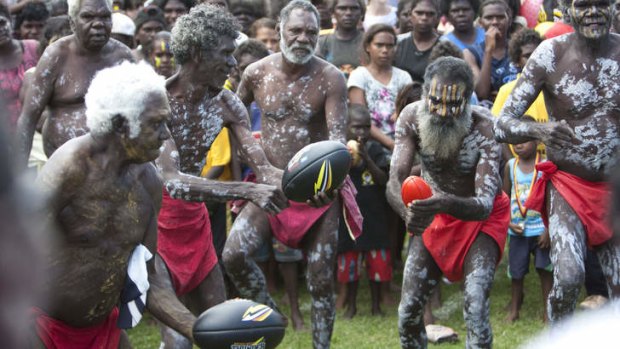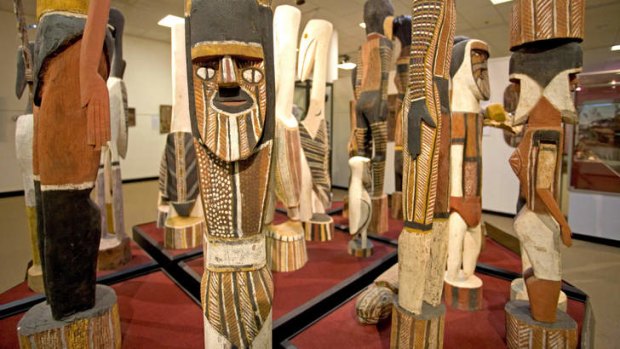This was published 11 years ago
Twenty reasons to visit Darwin
Lee Atkinson gives 20 good reasons to visit the hub of the Top End.

AFL fanatics: The Tiwi Islands, close to Darwin, are famous for their love of the Sherrin.
1 SWIM WITH A CROCODILE
Taking a swim in water that you know is home to saltwater crocodiles is a no-no in the Top End, but at Crocosaurus Cove in the middle of Darwin you can climb into a perspex tube - called the Cage of Death - and take a dip in the crocodile enclosure. Nine times out of 10 the croc, who has seen it all before, will ignore you, but occasionally he'll come up close for a look, giving you an eyeball-to-eyeball encounter.

Find great art and a spooky Cyclone Tracy experience at The Museum and Art Gallery of the Northern Territory.Credit: Alamy
2 JUMPING CROCS
If you really want to eyeball a saltie but don't like the sound of the Cage of Death, take a Jumping Crocodile Cruise on the Adelaide River, around 70 kilometres from Darwin on the Arnhem Highway. A few different operators cruise the waterway, and they all entice huge saltwater crocodiles with a piece of meat on a stick, making them leap into the air for their supper. If you're in a double-decker boat, sit downstairs for a closer look.
See travelnt.com.
3 CATCH A WAVE
Darwin's got some great beaches, but just like the rivers and billabongs, they are often home to dangerous salties. Head instead to the wave pool and free swimming lagoon at the Darwin Waterfront. Supervised by lifeguards and crocodile- and stinger-free, the two pools are open every day, and during the dry season there's often free entertainment as well.
4 EAST POINT RESERVE
Darwin's largest park, East Point Reserve on the shores of Fannie Bay, is another spot where you can get wet without fear of jellyfish or crocodiles in the artificial lake, Lake Alexander. Fannie Bay Beach has free barbecues and playgrounds, there's a mangrove boardwalk, bicycle track and lots of wallabies, as well as some interesting gun emplacements left over from World War II.
5 LITCHFIELD NATIONAL PARK
If you really do want to get wet in the wild, drive south out of town for an hour or so (120 kilometres) to Litchfield National Park. Here you can cool off in several deep croc-free plunge pools fed by beautiful waterfalls: top spots include Wangi Falls, Florence Falls and kid-friendly Buley Rockhole.
6 SHOPPING
The locals will tell you that Darwin has the best shopping for 1000 miles, but if you've come to Darwin just to shop you might be disappointed. There are some hidden gems, though - in Smith Street Mall the Star Village arcade is home to some good vintage and quirky boutiques, hand-made chocolate and the Four Birds cafe. Raw Cloth at Nightcliff is another shop worth seeking out - it specialises in hand-painted fabrics, many by indigenous artists from Maningrida and Merrepen, which you can buy by the length or made up into a vintage-styled dress. 3/60 Aralia St, Nightcliff.
7 MARKETS
The best shopping in Darwin is at one of the weekly markets. The largest is Mindil Beach Sunset Markets, which runs from April until October on Thursday and Sunday nights. Almost as popular is the Saturday morning Parap Village Market (really good laksa and tropical smoothies), but if you want to rub shoulders with the locals the two Sunday morning markets at Nightlife and Rapid Creek are great breakfast spots.
8 LISTEN TO THE WIND HOWL
The Museum and Art Gallery of the Northern Territory is the place to go to see some great Aboriginal art and some very big stuffed crocodiles, but the most memorable exhibit is the Cyclone Tracy display. The cyclone hit Darwin on Christmas Eve in 1974, and the howling winds were recorded by a priest who was taping children singing carols. Being alone in the small dark room where the recording is played is almost as terrifying as hearing the real thing.
See magnt.nt.gov.au.
9 SEAFRONT SUNDOWNER
Time your visit to the museum so you can cross the road to the Ski Club afterwards to watch the sunset with a coldie in hand. Don't expect flash - it's plastic chairs, plastic cups and a string of fairy lights strung between a couple of palm trees - but the food and drinks are cheap, there's a playground for kids and the beachside view is as good as it gets. It's open from noon each day and is opposite the gallery and museum on Conacher Street.
10 TOAST THE SUNSET
The ski club's not the only spot to watch the best daily light show in town. Other good vantage points include Mindil Beach, a picnic rug overlooking Fannie Bay in East Point Reserve or from the deck of a catamaran in the middle of Darwin Harbour while sipping champagne or a cold beer.
11 WATCH A MOVIE UNDER THE STARS
Once the sun has left the sky, the next best outdoor show in town is the Deckchair Cinema, where you can catch the latest arthouse film and occasional blockbuster in an outdoor theatre on the harbour's edge. It runs seven nights a week during the dry season (April to November). You can buy wine, beer and soft drinks at the kiosk, as well as snacks, or bring your own picnic dinner.
12 GET OUT OF GAOL FREE
Opened in 1883, the notorious Fannie Bay Gaol was home to criminals and their like for almost 100 years until 1979. It's now open to tourists, but they haven't really done anything to have it prettied up - the crude facilities, stark cells and chilling gallows will help you stay on the straight and narrow. Entry is free and it's the perfect day out if you have wayward teenagers who need some motivation to toe the line.
13 FIND SOME SHADE
The wet season is November through to April, but Darwin can be hot and steamy all year round. Chill out on a leisurely stroll through the rainforest gully with hundreds of palms or along the mangrove boardwalk at the George Brown Botanic Gardens. The 42-hectare gardens feature some impressive tropical blooms and are a great spot for a picnic or to let the kids run off some energy.
14 DEFENCE OF DARWIN
Darwin was Australia's front line during World War II, when Japanese bombers attacked the city in more than 64 raids. The biggest was on February 19, 1942, when 188 Japanese planes bombed the city and harbour, which was full of Allied warships, killing about 235 people. The story of the day, and Darwin's role in the war, is retold in the new Defence of Darwin Experience at East Point. It's next door to the older Darwin Military Museum, which has lots of guns and other military equipment on show.
See defenceofdarwin.nt.gov.au.
15 EXPLORE DARWIN'S UNDERGROUND
After the bombing raid, the powers-that-be decided to build a network of tunnels beneath the city to store oil and other inflammables. The tunnels were completed before the end of the war, but were never actually used, and were boarded up and forgotten about until 1992, when they were reopened to commemorate the 50th anniversary of the Bombing of Darwin. There is a photographic display of Darwin during the war inside the tunnels, but otherwise, they have been pretty much left just as they were during the war. You'll find the entrance on Kitchener Drive.
16 SEE HOW DARWIN USED TO BE
Between the bombing raids of World War II and the devastation of Cyclone Tracy, there is very little of pre-war Darwin that has survived. Wander around Myilly Point Heritage Precinct, a collection of older homes not far from Cullen Bay, and you'll get a sense of what Darwin might once have been like. The precinct includes four of the city's last remaining pre-World War II houses. Burnett House has been furnished much as it would have been when it was built, back when there were no airconditioners and bedrooms were always on the verandah. High Teas are held every Sunday afternoon in the gardens from 3pm to 5pm.
17 CATCH A BARRAMUNDI
The waterways of the Top End are not just home to crocodiles - the prized barramundi is the most highly sought after fish, and the best time to land one is between September and December. They can be caught in the open sea, harbours, estuaries, creeks, rivers and billabongs.
18 GO GREEK
Closer to Singapore than it is to Perth, Darwin is pretty famous for its range of authentic Asian-style eateries, particularly the food stalls at any of the local markets. It's less well known, but the city also has a large Greek community. Sweet Tooth in the suburb of Millner near Rapid Creek (3/6 Sabine Road) has the locals lining up for delicious Greek treats and pastries, while Manoli's in the city centre (64 Smith Street) does a knockout souvlaki and other traditional Greek fare.
19 GO PLANE SPOTTING
Check out the B52 bomber at the Australian Aviation Heritage Centre. The plane crashed west of Tennant Creek in 1945 and was recovered in 1974. Other exhibits include a Spitfire, a Wessex helicopter, a Sabre jet and displays of Australian aviation history. The newest aircraft on display is a recently retired RAAF F-111 jet.
20 TIWI ISLANDS
As famous for its passion for football (AFL) as its distinctive art and the Pukumani burial poles, the Tiwi Islands, which are made up of Bathurst and Melville islands, are only 60 kilometres from Darwin across the Timor Sea and an easy 20-minute flight. Tiwi Tours (in conjunction with Aussie Adventure Tours) run day trips to Bathurst and Melville islands and will organise permits on your behalf. Highlights are visiting the art galleries and morning tea with some of the local ladies.
The writer was a guest of Tourism NT.
Sign up for the Traveller newsletter
The latest travel news, tips and inspiration delivered to your inbox. Sign up now.